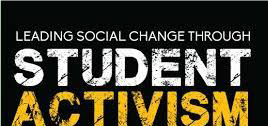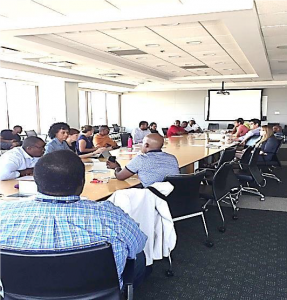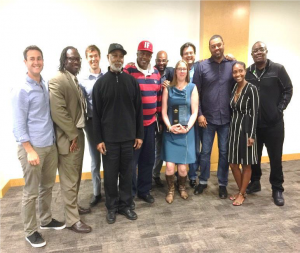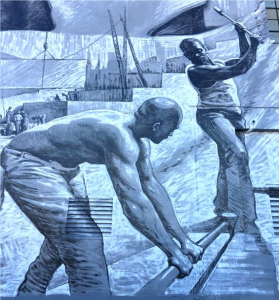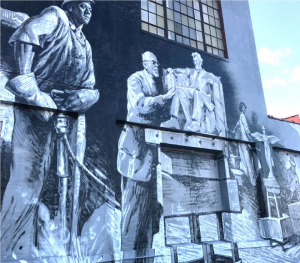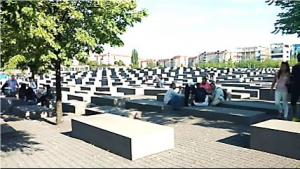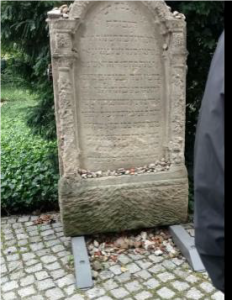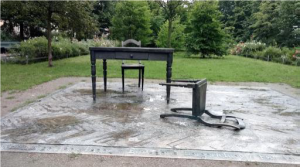By Marisa Allison, Carrie Hutnick, and Emily McDonald
Following the 2016 elections, members of the Public Sociology Association at George Mason University began a project in attempt to create a community of scholar-activists on our campus. Recognizing the tremendous amount of activist and advocacy work that has been happening in different spheres on our campus, we felt called to use the tools we have developed as public sociologists to lay a groundwork that could help create a network of support during a time of rising attacks on students, faculty, and staff who engage in social justice and liberation work across the U.S. On September 1, the Public Sociology Association invited student activists across campus to come together for a day of reflection and getting to know one another. Our group is now in the process of determining next steps in terms of how to best create a collaborative network of scholar-activists, supporting work that is already present rather than recreating strategies and efforts already in place. What we recount here are a series of lessons that we continue to work through as we strive to create a community of scholar-activists on our campus.
While there are sociologists working outside of academia, a large part of our discipline remains housed in the university. In debates around practicing public sociology, and using sociological inquiry as a means of activism, distinctions are often made between sociologists who work inside the academy and those who do not. As noted by Michael Burawoy in his 2004 ASA Presidential address, such a distinction draws a line between university-based sociologists as the “professionals” who publish for academic audiences and other sociologists engaged in activism, policy debates, and contributing to decisions not necessarily particular to university communities. Yet, there are incredible networks of activist students, faculty, and professional staff that exemplify how the university is embedded in and reflective of the “real” world. Inequality does not dissipate at the classroom door. As Mason’s Vice President for University Life and Mason Sociology alumna Rose Pascarell stated in her address to the Public Sociology Association last year: “If it’s happening in the ‘real’ world, it’s happening here.”
Lesson One
Much of the important advocacy and activist work already underway on campus is invisible to much of the broader university community. As those seeking to build a scholar- activist community, we must recognize the importance of the activist and advocacy work that is already happening. Many of the issues on campus emerge specifically due to our status as students, staff, and faculty, which make us actors within an institution with lived experiences shaped by it, while giving our actions meaning in shaping the university.
For example, in September of this year, the student group “Transparent GMU” went to court after suing the university and the university foundation for not being transparent about donor agreements. This student group is already connected to the UnKoch My Campus initiative, and if their case succeeds, it will not only allow decades of donor agreements to be made public at GMU, which could unmask donor influence over course content, faculty scholarship, and hiring, tenure, and promotion, but it could also set a precedent that would allow anyone to ask for transparency in donor agreements at public universities across the U.S. Such a precedent could potentially disclose efforts made by corporate foundations to influence public perception and public policy under the guise of unbiased research and scholarship that comes out of public universities, but which ultimately benefit corporate interests. Such efforts may seem small in scope, yet could potentially create systemic change by encouraging free speech and autonomy both within and outside the academy. Student activism is often framed as somehow less legitimate “practice” for the “real” world, yet we know the work done by these students is transformative. On the other hand, faculty/staff activism can be suppressed due to their employment status within the university. A scholar-activist community, therefore, must learn to “see” and support one another, in an environment that tends to render us invisible to one another.
Lesson Two
Public sociologists have something unique to contribute to coalition and community building within activist spaces because of our work as both scholars and activists as well as our commitment to centering and highlighting the work of the publics we engage with. In this way we can help bridge and support current work that individual scholars and groups of activists are doing without recreating existing efforts.
As sociologists, we identified our potential capacity for theoretical analysis of social issues, our training and experience as instructors in leading students in developing tools for analysis, and our ability to support movements for social transformation through research to support groups engaged in activism on campus. As public sociologists, we reflected on our ability to build relationships with populations we seek to support and allow those directly experiencing issues of inequality to maintain their own voice in activist spaces, define their needs for our support, and have ownership over implementation of tools and information we might provide.
We do not necessarily look to transform practices already in place or claim expertise in issues we ourselves are not directly connected to through scholarship or activism. Rather, we hope to help these groups connect their more immediate efforts of creating effective communities of change to structural efforts that can help them understand how the issues they address are interconnected and influence one another.
We hope to work with groups on campus addressing particular issues and working for liberation to create more collaborative networks by finding connections with each other, and with sociological tools of analysis, help them identify ways those connections mirror the structural issues they are facing. This is a reciprocal, mutually beneficial learning process that can inform work as a community rather than a one-way relationship of information sharing.
Lesson Three
Whether we are scholars, activists, or both, when we individually (or collectively) work on any liberation/justice project, that undertaking becomes the main focus of our efforts. One issue in forming a community where the goal is to support and give equal recognition and attention to every project/issue people are addressing in their work is that our current climate makes each different project being addressed a priority. Therefore, supporting the work that the Mason DREAMers are doing around the president’s ending of DACA (Deferred Action for Childhood Arrivals) is equally important as supporting the faculty and graduate students producing scholarship about white supremacy in response to the events that occurred in Charlottesville.
Ultimately, creating a community of scholar-activists is the best way to support all of the projects that scholar-activists are working on within our campus community. Such an effort requires an active commitment to centering the mission of collaboration rather than centering one specific mission of one specific group. A support network is both showing up for one another when needed without sacrificing one’s own commitment to a particular issue.
No one aspect of liberation work is centered as the most important. Striking the balance between actively creating shared space to come together without reproducing the traumatic silencing many groups experience due to their progressive mission, or due to the identities of the activists themselves, is a challenge our group continues to work through.
One of the key lessons learned in coming together and exploring the idea of how we even begin to create shared spaces as scholar-activists is the recognition that coalition-building is a messy process with no clear answers. As scholars and graduate students, we are often left silent and immobilized with the anxiety of “finding” the answers.
However, this process is ultimately an invitation to dialogue rather than a process of creating the perfect handbook. Our process is rooted in that of “seeing” one another first, overcoming the boundaries that often separate activists engaging in this important liberation work.
As bell hooks stated in her reflections on practicing education as freedom: “Our capacity to generate excitement [in a learning environment] is deeply affected by our interest in one another, in hearing one another’s voices, in recognizing one another’s presence” (1994:8).
Our next steps in terms of taking concrete actions are to continue supporting the work of activists on our campus while continually inviting them to come together. It is our hope that this effort grows. If interested in starting something similar on your own campus, feel free to reach out to us at any time.
References:
Burawoy, Michael. 2005. For Public Sociology. American Sociological Review, 70(1), 4-28.
hooks, bell. 1994. Teaching to Transgress: Education as the Practice of Freedom. New York: Routledge.

